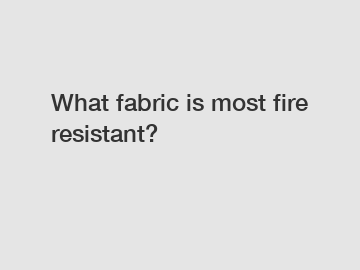What fabric is most fire resistant?
In the realm of safety and protection, fire resistance stands as an indispensable quality. From firefighters tackling blazing infernos to workers in hazardous environments, the right fabric can make all the difference. However, with a multitude of fabrics flooding the market, it can be perplexing to discern which one offers the highest degree of fire resistance. Fear not, for in this blog, we embark on a quest to uncover the fabric that stands above all for its remarkable resistance to flames.
1. Firefighters' Favorite: Nomex.
When the heat is scorching and the flames are roaring, one fabric that comes to the rescue is Nomex. Developed by DuPont, Nomex fabric has become a staple in firefighting gear. Composed of inherently flame-resistant meta-aramid fibers, it exhibits exceptional thermal stability. Nomex can withstand the onslaught of high temperatures and resists ignition, making it a top choice for firefighting operations globally.

2. The Sovereign of Industrial Settings: Kevlar.
Kevlar, another synthetic fiber developed by DuPont, predominantly known for its incredible strength, also boasts remarkable fire-resistant properties. Originally created as a material for bulletproof vests, Kevlar has found its way into numerous industrial applications. Exhibiting high thermal stability, Kevlar fibers do not melt or drip when exposed to extreme heat. This property has made it invaluable in manufacturing protective clothing for personnel working in hazardous environments.
3. Wool: The Natural Warrior.
When it comes to natural fibers, wool undoubtedly takes the crown as one of the most fire-resistant options. Known for centuries for its incredible ability to self-extinguish, wool fibers possess a high ignition threshold due to their complex cellular structure. In addition, wool contains a naturally occurring protein called keratin, which releases water vapor when heated. This moisture acts as a coolant and helps to suppress flames, effectively protecting the wearer.
4. The Art of Weaving Fiberglass.
While not as commonly used in clothing, fiberglass is often incorporated into specialized applications and insulation. As a result of its composition—glass fibers intertwined with plastic or resin—fiberglass provides excellent fire resistance. It can endure intense heat without igniting or releasing toxic gases. Though not the go-to fabric for everyday fire resistance needs, fiberglass is highly effective in construction and heat insulation.
5. The Intriguing Alchemy of Silica.
Silica, most commonly found in sand and quartz, might not seem like an obvious choice for fire resistance at first glance. But the wonders of science have proven otherwise. Silica fabrics, often in the form of a woven fiberglass-silica composite, exhibit an exceptional ability to withstand high temperatures. With a melting point of 3,092 degrees Fahrenheit (1,700 degrees Celsius), it is an outstanding choice for environments involving extreme heat and molten metal hazards.
6. The Extraterrestrial Survivor: Carbon Fiber.
One of the most robust materials known to humankind, carbon fiber, also showcases impressive fire-resistant properties. Its high resistance to heat and flame comes from a combination of its unique composition and tightly bonded carbon atoms. Carbon fiber stands strong under intense temperatures, making it an ideal fabric for various high-risk industries, including aerospace and motorsports.
Conclusion:
When it comes to fire-resistant fabrics, no single option suits every situation. The ideal choice depends on the specific environment, exposure to extreme heat, and industry requirements. Nomex and Kevlar, with their impressive technological advancements, excel in protecting firefighters and workers in hazardous settings. On the other hand, natural fabrics like wool offer self-extinguishing properties and excellent insulation. Fiberglass, silica, and carbon fiber cater to specific needs, such as construction, molten metal protection, and aerospace applications.
Remember, the key is to determine the most suitable fabric based on the desired level of fire resistance required for a given situation. Consult experts, adhere to safety guidelines, and always prioritize the welfare and protection of those at risk. By understanding these remarkable fabrics and their unique attributes, we can pave the way for safer and more secure environments for all.
If you want to learn more, please visit our website Buy Fire Retardant Fabric, Flame Resistance Fabric, is cotton fireproof.
160
0
0


Comments
All Comments (0)